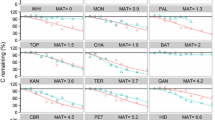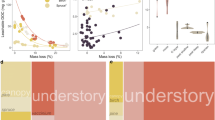Summary
The forest floor is a major reservoir of organic matter and nutrients for the ecosystem and as such it influences or regulates most of the functional processes occurring throughout the ecosystem. This study reports on the nutrient and organic matter content of the forest floor of the Hubbard Brook Experimental Forest during different seasons and attempts to correlate results from studies of vegetation, litter, decomposition, stemflow, throughfall, and soil. An organic matter budget is presented for an undisturbed watershed.
Average weight of the forest floor on an undisturbed watershed ranged from 25,500 to 85,500 kg/ha. The weighted watershed average was 46,800 kg/ha. Although the F and H horizons did not vary significantly with time, the L horizon increased significantly during the period June to August largely as a result of a severe hail storm. The order of abundance of elements in the forest floor was Nτ;Ca≷Fe>S>P>Mn>K>Mg>Na>Zn>Cu. The concentrations of Ca, K, and Mn decreased with depth in the forest floor while N, P, S, Na, Fe, Zn, and Cu concentrations increased. N:P ratios were similar in decomposing leaf tissue, the forest floor, litterfall, and net stemflow plus throughfall suggesting a similar pattern of cycling. S was proportional to N and P in decomposing leaf tissue, the forest floor, and litterfall. Net stemflow and throughfall were affected by a relatively large input of SO4=-S from the atmosphere. Residence times for elements in the forest floor were affected by inputs other than litterfall (precipitation, stemflow, and throughfall). Calculation of residence times using all inputs caused smaller values than if litterfall alone was used. While all residence times were reduced, the major differences occurred for K, S, and Na. N and P showed relatively long residence times as a result of retranslocation and immobilization by decomposers. The slow turnover rate because of the strong demand and retention by all biota must account for the efficiency of the intrasystem cycling process for N and P. K showed the shortest residence time. A rapid and efficient uptake of K by vegetation seems to account for the efficient cycling of this element. The patterns of nutrient cycling are several depending on the chemical properties of the forest floor, and nutritional requirements of the biota.
Similar content being viewed by others
References
Bormann, F. H., Likens, G. E.: Nutrient cycling. Science 155, 424–429 (1967)
Bormann, F. H., Likens, G. E., Eaton, J. S.: Biotic regulation of particulate and solution losses from a forest ecosystem. Bio. Sci. 19, 600–610 (1969)
Bormann, F. H., Likens, G. E., Siccama, T. G., Pierce, R. S., Eaton, J. S.: The effect of deforestation on ecosystem export and the steady-state condition at Hubbard Brook. Ecol. Monogr. 44, 255–277 (1974)
Bormann, F. H., Siccama, T. G., Likens, G. E., Whittaker, R. H.: The Hubbard Brook ecosystem study: Composition and dynamics of the tree vegetation. Ecol. Monogr. 40, 373–388 (1970)
Dominski, A. S.: Nitrogen transformation in a northern-hardwood podzol on cutover and forested sites. Ph. D. Dissertation, Graduate School, Yale University (1971)
Eaton, J. S., Likens, G. E., Bormann, F. H.: Throughfall and stemflow chemistry in a northern hardwood forest. J. Ecol. 61, 495–508 (1973)
Fisher, S. G., Likens, G. E.: Stream ecosystem: organic energy budget. Bio. Sci. 22, 33–35 (1972)
Gauch, H. G.: Inorganic plant nutrition, 488 p. Stroudsberg, Pa.: Dowden, Hutchison & Ross 1972
Gosz, J. R., Likens, G. E., Bormann, F. H.: Nutrient content of litter fall on the Hubbard Brook Experimental Forest, New Hampshire. Ecol. 53, 769–784 (1972)
Gosz, J. R., Likens, G. E., Bormann, F. H.: Nutrient release from decomposing leaf and branch litter in the Hubbard Brook Forest, New Hampshire. Ecol. Monogr. 43, 173–191 (1973)
Hart, G.: Humus depths under cut and uncut northern hardwood forests. N.E. For. Exp. Stat. Research Note 113 (1961)
Johnson, C. M., Ulrich, A.: Analytical methods for use in plant analysis. Calif. Agric. Exp. Sta. Bull. No. 766, 78 p. (1959)
Johnson, N. M., Likens, G. E., Bormann, F. H., Pierce, R. S.: Rate of chemical weathering of silicate minerals in New Hampshire. Geochem. Cosmochem. Acta 32, 531–545 (1968)
Kramer, P. J., Kozlowski, T. T.: Physiology of trees, 642 p. New York: McGraw-Hill 1960
Likens, G. E., Bormann, F. H.: Chemical analyses of plant tissues from the Hubbard Brook Ecosystem in New Hampshire. Yale University School of Forestry Bull. No. 79, 25 p. (1970)
Likens, G. E., Bormann, F. H.: Nutrient cycling in ecosystems, p. 25–67. In: J. Wiens, ed., Ecosystems: structure and function, 176 p. Corvallis, Oregon: Oregon State Univ. Press 1972
Likens, G. E., Bormann, F. H., Johnson, N. M., Fisher, D. W., Pierce, R. S.: Effects of forest cutting and herbicide treatment on nutrient budgets in the Hubbard Brook Watershed Ecosystem. Ecol. Monogr. 40, 23–47 (1970)
Likens, G. E., Bormann, F. H., Johnson, N. M., Pierce, R. S.: The calcium, magnesium, potassium, and sodium budgets for a small forested ecosystem. Ecol. 48, 772–785 (1967)
Likens, G. E., Bormann, F. H., Pierce, R. S., Fisher, D. W., Eaton, J. S.: Biogeochemical cycling in a northern hardwood forest ecosystem. In preparation
Lunt, H. A.: Profile characteristics of New England forest soils. Conn. Agric. Exp. Sta. Bull. No. 342, p. 743–836 (1932)
McKenzie, H. A., Wallace, H. S.: The Kjeldahl determination of nitrogen: a critical study of digestion conditions-temperature, catalyst, and oxidizing agent. Aust. J. Chem. 7, 55–70 (1954)
Olson, J. S.: Energy storage and the balance of producers and decomposers in ecological system. Ecol. 44, 322–331 (1963)
Ovington, J. D.: Quantitative ecology and the woodland ecosystem concept. Adv. Ecol. Res. 1, 103–192 (1962)
Ovington, J. D.: Organic production, turnover and mineral cycling in woodlands. Biol. Rev. 40, 295–336 (1962)
Pierce, R. S., Martin, C. W., Reeves, C., Likens, G. E., Bormann, F. H.: Nutrient losses from clearcutting in New Hampshire, p. 285–295. In: Nat' l Symp. on Watersheds in Transition, Amer. Water Resources Assoc. Proc. Series No. 14 (1972)
Reichle, D. F.: Energy and nutrient metabolism of soil and litter invertebrates. Symposium on the productivity of forest ecosystems of the world. Palaises des Congres, Brussels, Belgium (1969)
Reiners, W. A.: Nutrient content of canopy throughfall in three Minnesota forests. Oikos 23, 14–22 (1972)
Reiners, W. A., Marks, R. H., Vitousek, P. M.: Heavy metals in subalpine and alpine soils of New Hampshire. Oikos (in press)
Reiners, W. A., Reiners, N. M.: Energy and nutrient dynamics of forest floors in three Minnesota forests. J. Ecol. 58, 497–519 (1970)
Rodin, L. E., Basilevich, N. I.: Production and mineral cycling in terrestrial vegetation (English translation ed. by G. E. Fogg), 288 p. Edinburgh-London: Oliver and Boyd 1967
Safford, L. O.: Effect of fertilization on biomass and nutrient content of fine roots in a beech-birch-maple stand. Second North Amer. Forest Biology Workshop, Corvallis, Oregon, Aug. 1972, Physiology-Ecology Section (1972)
Siccama, T. G., Bormann, F. H., Likens, G. E.: The Hubbard Brook Ecosystem Study: Productivity, nutrients, and phytosociology of the herbaceous layer. Ecol. Monogr. 40, 389–402 (1970)
Smith, W. H.: Tree root exudates and the forest soil ecosystem: Exudate chemistry, biological significance and alteration by stress. In: J. Marshall, ed., A Symposium on the Below Ground Ecosystem: A synthesis of plant-associated processes, Sept. 5–7, 1973. Fort Collins, Colo. (in press)
Stone, E. L.: Microelement nutrition of forest trees: A review, p. 132–175. In: Forest fertilization, theory and practice, 306 p. Muscle Shoals, Albama: Tenn. Valley Auth. Natl. Fertilizer Development Center 1968
Tukey, A. B., Jr.: The leaching of substances from plants. Ann. Rev. Pl. Phys. 21, 305–332 (1970)
Whittaker, R. G., Likens, G. E., Bormann, F. H.: The Hubbard Brook Ecosystem Study: Forest biomass and production. Ecol. Monogr. 44, 233–252 (1974)
Wilde, S. A.: Forest humus: Its classification on a genetic basis. Soil Sci. 111 (1), 1–12 (1971)
Author information
Authors and Affiliations
Additional information
This is contribution No. 67 of the Hubbard Brook Ecosystem Study. Financial support was provided by the National Science Foundation.
Rights and permissions
About this article
Cite this article
Gosz, J.R., Likens, G.E. & Bormann, F.H. Organic matter and nutrient dynamics of the forest and forest floor in the Hubbard Brook forest. Oecologia 22, 305–320 (1976). https://doi.org/10.1007/BF00345310
Received:
Issue Date:
DOI: https://doi.org/10.1007/BF00345310




